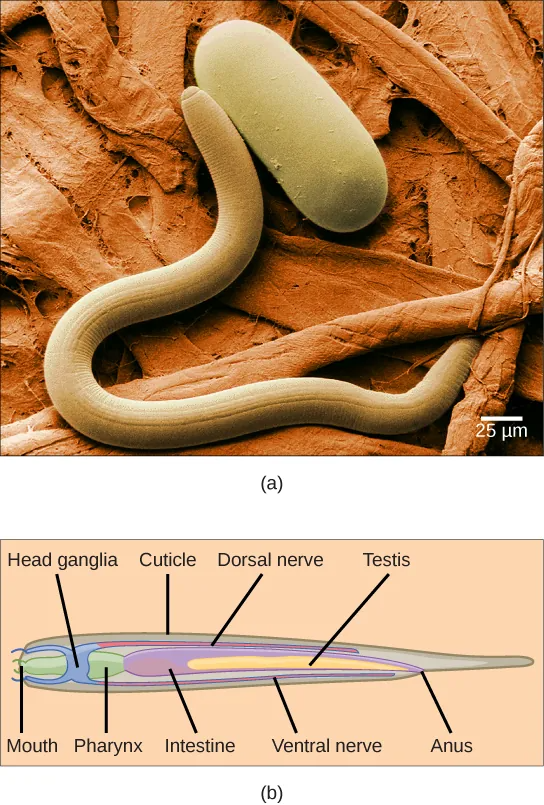28.5 Phylum Nematoda (Superphylum Ecdysozoa)
Learning Outcomes
- Describe the structural organization of nematodes
Superphylum Ecdysozoa
The superphylum Ecdysozoa contains an incredibly large number of species. This is because it contains two of the most diverse animal groups: phylum Nematoda (the roundworms) and phylum Arthropoda (the arthropods). The most prominent distinguishing feature of ecdysozoans is the cuticle—a tough, but flexible exoskeleton that protects these animals from water loss, predators, and other dangers of the external environment. All members of this superphylum periodically go through a molting process that culminates in ecdysis—the actual shedding of the old exoskeleton. (The term “ecdysis” translates roughly as “take off” or “strip.”) During the molting process, old cuticle is replaced by a new cuticle, which is secreted beneath it, and which will last until the next growth period.
Phylum Nematoda
The Nematoda, like other members of the superphylum Ecdysozoa, are triploblastic and possess an embryonic mesoderm that is sandwiched between the ectoderm and endoderm. They are also bilaterally symmetrical, meaning that a longitudinal section will divide them into right and left sides that are superficially symmetrical. In contrast with flatworms, nematodes are pseudocoelomates and show a tubular morphology and circular cross-section. Nematodes include both free-living and parasitic forms.
The name Nematoda is derived from the Greek word “Nemos,” which means “thread,” and includes all true roundworms. Nematodes are present in all habitats, typically with each species occurring in great abundance. The free-living nematode, Caenorhabditis elegans, has been extensively used as a model system for many different avenues of biological inquiry in laboratories all over the world.
Morphology
The cylindrical body form of the nematodes is seen in Figure 28.32. These animals have a complete digestive system with a distinct mouth and anus, whereas only one opening is present in the digestive tract of flatworms. The mouth opens into a muscular pharynx and intestine, which leads to a rectum and anal opening at the posterior end. . The cuticle of nematodes is rich in collagen and a polymer called chitin, which forms a protective armor outside the epidermis.

In nematodes, specialized excretory systems are not well developed. Nitrogenous wastes, largely in the form of ammonia, are released directly across the body wall. In some nematodes, osmoregulation and salt balance are performed by simple excretory cells or glands that may be connected to paired canals that release wastes through an anterior pore.
Most nematodes have four longitudinal nerve cords that run along the length of the body in dorsal, ventral, and lateral positions. Nonetheless, all nerve cords fuse at the anterior end, to form a pharyngeal nerve ring around the pharynx, which acts as the head ganglion or the “brain” of the roundworm. A similar fusion forms a posterior ganglion at the tail.
Nematodes employ a variety of reproductive strategies ranging from monoecious to dioecious to parthenogenetic, depending upon the species.

